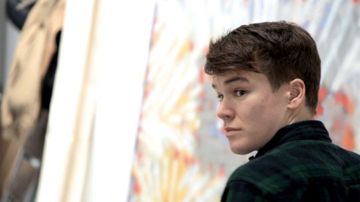While watching Keltie Ferris Spray Paints in Solitude, I kept wondering to myself… What can students and teachers learn from engaging with this five minutes of film? I wanted a reason to share it because I was so enamored with her love of color, her approach to abstraction, even her definition of abstraction, and all the while not taking herself too seriously. After all, she is an artist who believes, “Making paintings is an enterprise in solitude,” and that, “It’s hard to do something that’s not justified by anything.”
After thinking about it for a while and hitting rewind a few times I decided that working with this film can initially be about Ferris’ approach to making art and simultaneously an opportunity to ask the questions: So why paint if she is well aware that her paintings aren’t something that’s necessarily needed in the world and could very well be in the dumpster tomorrow? Does Ferris make sense of the world by trying to “see through to other worlds”? Can painting be, like it is for many of us, a form of meditation? What does she gain by working in solitude? What do viewers gain by engaging with her paintings?
Sorry. All I have are questions this week.
What I also enjoy is watching Ferris share Josef Albers’ work and being blown away by it. I enjoy the way she talks about abstraction as “trying to undo the nameable things in life”. I enjoy the fact that she lets us into her studio to see a work in progress that she considers awful. There’s an excitement in the way she talks about her art that’s infectious.
One more idea… Juxtaposing Keltie Ferris, a painter who obviously fits the image of an artist slaving over a hot canvas, with someone like Fred Wilson, Oliver Herring or even Allora and Calzadilla, can broaden a student’s perspective on what being an artist looks like today. It allows for contrasting her approach with artists that specifically engage with people in order to realize their work.




